1995 CHEVROLET CORVETTE high beam
[x] Cancel search: high beamPage 11 of 386
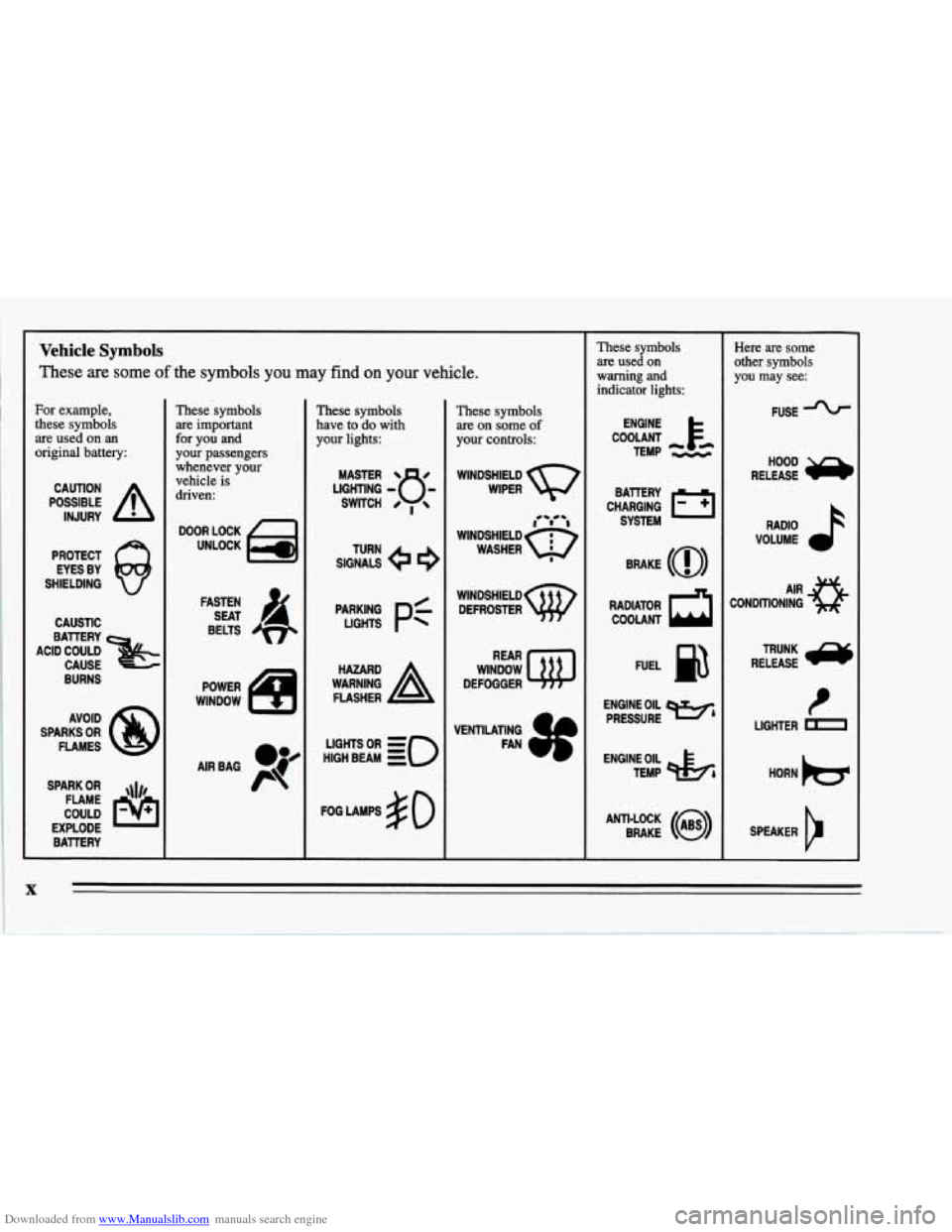
Downloaded from www.Manualslib.com manuals search engine Vehicle Symbols
These are some of the symbols you may find on your vehicle.
For example,
these symbols
are used on an
original battery:
POSSIBLE A
CAUTION
INJURY
PROTECT EYES BY
SHIELDING
Q
CAUSTIC
ACID COULD
&
BATTERY CAUSE
AVOID
SPARKS
OR
FLAMES
SPARK
OR ,\I/,
COULD FLAME
EXPLODE BATTERY
These symbols
are important
for you and
your passengers whenever your
vehicle
is
driven:
DOOR LOCK
UNLOCK
FASTEN SEAT
4
BELTS
POWER
WINDOW
AIRBAG P
These symbols
have to do with
your lights:
SIGNALS e e
TURN
p:
HIGH BEAM OR = so
FOG LAMPS # 0
These symbols
are on some
of
your controls:
WINDSHIELD
WIPER
WINDSHIELD DEFROSTER
WINDOW
DEFOGGER
VENTILATING FAN
These symbols
are used
on
warning and
indicator lights:
ENGINE
TEMP
--
CHARGING I-1
BATTERY SYSTEM
RADIATOR
COOLANT a
FUEL
ENGINE OIL PRESSURE
Wb
TEMP OtL ctlb
ANTI-LOCK (@)
BRAKE
~~ ~~~ ~ ~~
Here are some
other symbols
you may see:
FUSE -%-
RELEASE
RADIO
VOLUME
CONDITIONING
AIR 43
t
LIGHTER D
HORN )cr
SPEAKER
b
X
Page 82 of 386
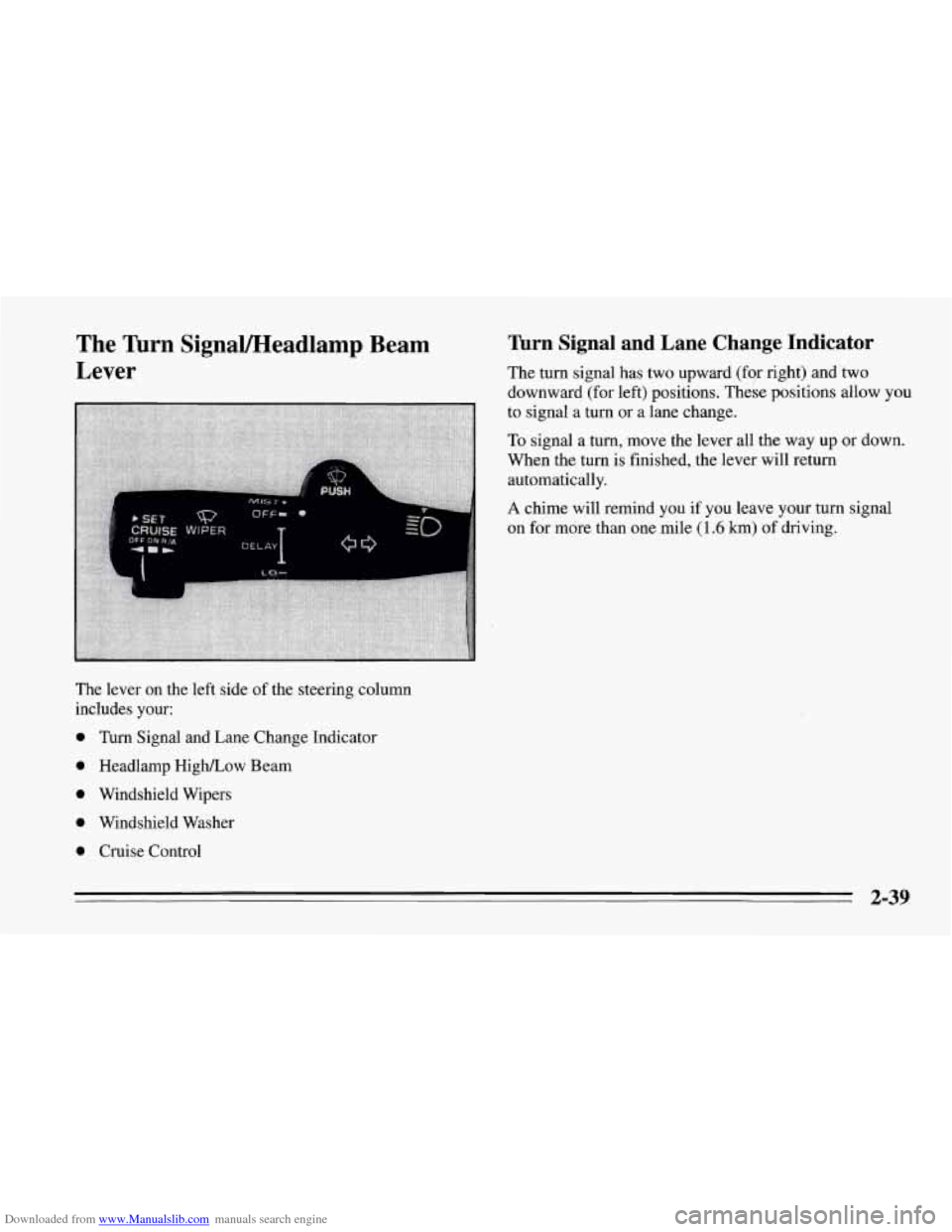
Downloaded from www.Manualslib.com manuals search engine The Turn SignaVHeadlamp Beam
Lever
The lever on the left side of the steering column
includes your:
0 Thm Signal and Lane Change Indicator
0 Headlamp HighPLow Beam
0 Windshield Wipers
0 Windsheld Washer
0 Cruise Control
Tbrn Signal and Lane Change Indicator
The turn signal has two upward (for right) and two
downward (for left) positions. These positions allow you
to signal a tum or a lane change.
To signal a turn, move the lever all the way up or down.
When the turn
is finished, the lever will return
automatically.
A chime will remind you if you leave your turn signal
on for more than one mile
(1.6 km) of driving.
2-39
Page 83 of 386
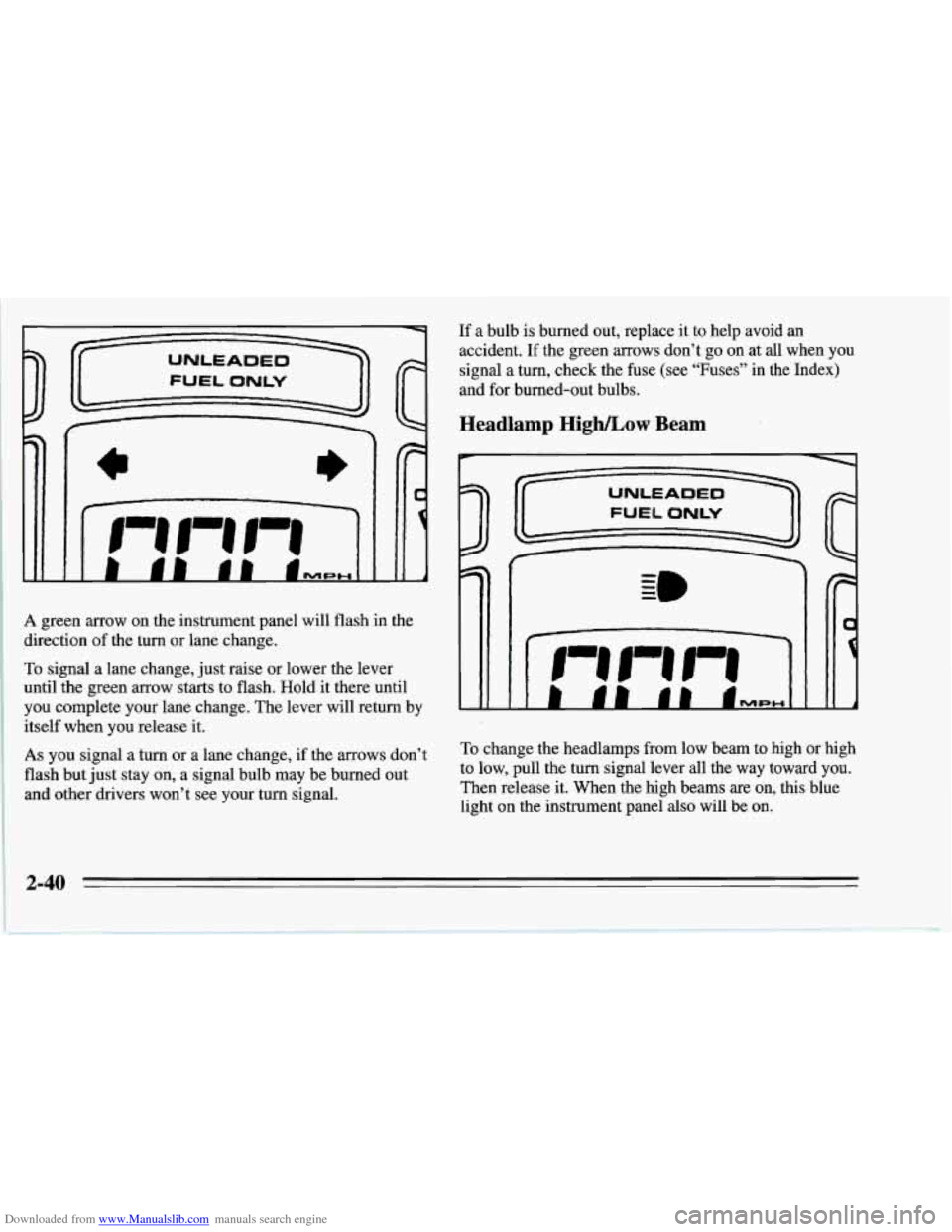
Downloaded from www.Manualslib.com manuals search engine A green arrow on the instrument panel will flash in the
direction
of the turn or lane change.
To signal a lane change, just raise or lower the lever
until the green arrow starts to flash. Hold it there until
you complete your lane change. The lever will return by
itself when you release it.
As you signal a turn or a lane change, if the arrows don’t
flash but just stay on, a signal bulb may be’burned out
and other drivers won’t see your turn signal.
If a bulb is burned out, replace it to help avoid an
accident. If the green arrows don’t go on at all when you
signal a turn, check the fuse (see “Fuses” in the Index)
and for burned-out bulbs.
Headlamp HighLow Beam
P
1 1
To change the headlamps from low beam to high or high
to low, pull the turn signal lever all the way toward you.
Then release it. When the high beams are
on, this blue
light
on the instrument panel also will be on.
2-40
Page 179 of 386
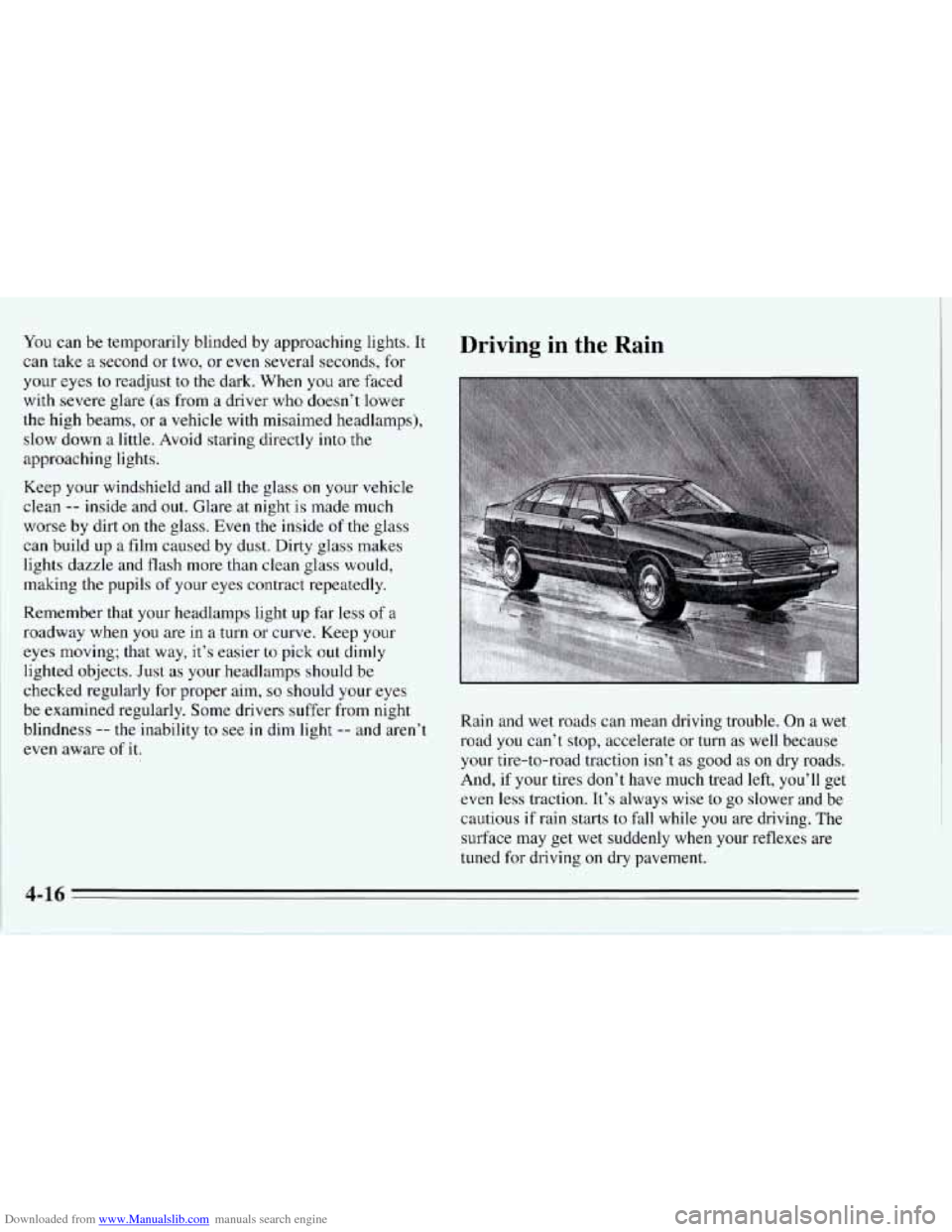
Downloaded from www.Manualslib.com manuals search engine You can be temporarily blinded by approaching lights. It
can take a second or two, or even several seconds, for
your eyes to readjust to the dark. When you are faced
with severe glare (as from a driver who doesn’t lower
the high beams, or a vehicle with misairned headlamps),
slow down a little. Avoid staring directly into the
approaching lights.
Keep your windshield and all the glass on your vehicle
clean
-- inside and out. Glare at night is made much
worse by dirt on the glass. Even the inside of the glass
can build up a film caused by dust. Dirty glass makes
lights dazzle and flash more than clean glass would,
making the pupils of your eyes contract repeatedly.
Remember that your headlamps light
up far less of a
roadway when you are
in a turn or curve. Keep your
eyes moving; that way, it’s easier
to pick out dimly
lighted objects. Just as your headlamps should
be
checked regularly for proper aim, so should your eyes
be examined regularly. Some drivers suffer from night
blindness
-- the inability to see in dim light -- and aren’t
even aware of it.
Driving in the Rain
Rain and wet roads can mean driving trouble. On a wet
road you can’t stop, accelerate or turn as well because
your tire-to-road traction isn’t as good as
on dry roads.
And,
if your tires don’t have much tread left, you’ll get
even
less traction. It’s always wise to go slower and be
cautious
if rain starts to fall while you are driving. The
surface may get wet suddenly when your reflexes are
tuned for driving on dry pavement.
4-16
Page 181 of 386
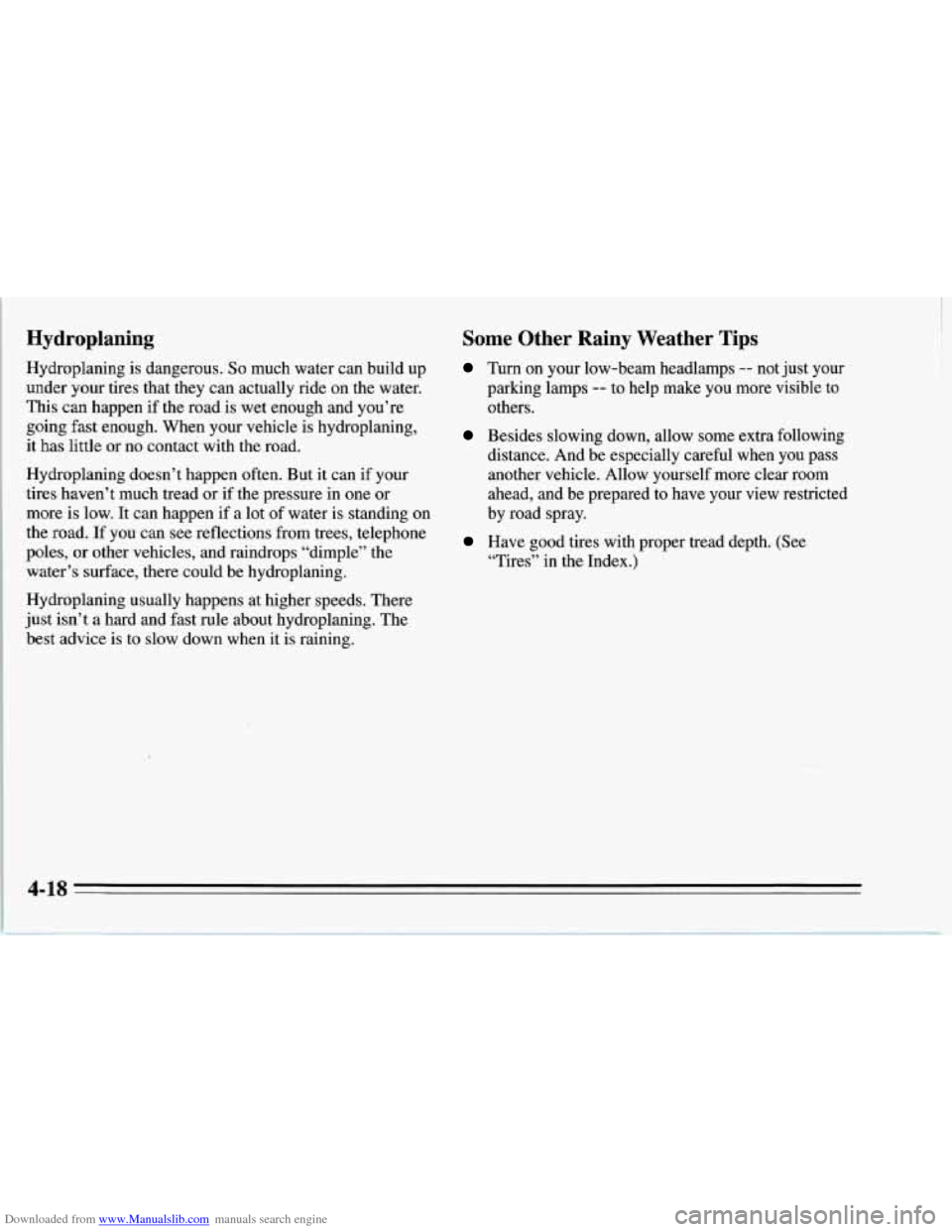
Downloaded from www.Manualslib.com manuals search engine Hydroplaning
Hydroplaning is dangerous. So much water can build up
under your tires that they can actually ride on the water.
This can happen if the road is wet enough and you’re
going fast enough. When your vehicle is hydroplaning,
it
has little or no contact with the road.
Hydroplaning doesn’t happen often. But it can if your
tires haven’t much tread or if the pressure in one or
more is low. It can happen if a lot of water is standing on
the road.
If you can see reflections from trees, telephone
~ poles, or other vehicles, and raindrops “dimple” the
~ water’s surface, there could be hydroplaning.
! Hydroplaning usually happens at higher speeds. There
1 just isn’t a hard and fast rule about hydroplaning. The
best advice
is to slow down when it is raining.
Some Other Rainy Weather Tips
Turn on your low-beam headlamps -- not just your
parking lamps
-- to help make you more visible to
others.
Besides slowing down, allow some extra following
distance. And be especially careful when you pass
another vehicle. Allow yourself more clear room
ahead, and be prepared to have your view restricted
by road spray.
“Tires” in the Index.)
Have good tires with proper tread depth. (See
Page 379 of 386

Downloaded from www.Manualslib.com manuals search engine Gasolines for Cleaner Air ........................ 6-4
Gauges Engine Coolant TemDerature
................... 2-74 " Engine Oil Pressure .......................... 2-80
Fuel ....................................... 2-83
Engine
Oil Temperature
....................... 2-81
Markings
................................... 2-82
GAWR (Gross Axle Weight Rating)
................ 4-28
GVWR (Gross Vehicle Weight Rating)
.............. 4-28
Glass,
Cleaning
................................ 6-59
Halogen Bulbs
................................ 6-36
Hardtop. Convertible
............................ 2-95
.Hatch Release. Remote
........................... 2-9
Hazard Warning Flashers
.......................... 5-1
Headlamp Doors ............................... 2-47
Headlamp HigWLow Beam Changer
................ 2-40
Headlamp. Wiring
.............................. 6-68
Headlamps, Bulb Replacement .................... 6-37
Heating, Manual
................................. 3-6
High Beam Lamps, How to Change
................ 2-40
High Fill Reservoir
(LT5 Engine) .................. 5-20
Highway Hypnosis
.............................. 4-22
Hill and Mountain Roads
......................... 4-22
HoodRelease
................................... 6-8
Horn
......................................... 2-38
Headlamps
.................................... 2-46
Hearing or Speech Impaired, Customer Assistance
...... 8-2
Heritage Pages
................................... 111 ...
Hydraulic Clutch ............................... 6-24
Hydraulic Clutch, Checking and Adding Fluid
........ 6-25
Hydroplaning
.................................. 4- 18
If You're Stuck: In Sand. Mud. Ice or Snow ......... 5-41
Ignition Key Positions
........................... 2-16
Ignition Switch
................................. 2-16
Inside Daymight Rearview Mirror
................. 2-49
Exhaust Systems
............................. 7-44
Manual Transmission
......................... 7-44
Rear Axle Service
............................ 7-44
Restraint Systems
............................ 7-44
Installing the Roof Panel
......................... 2-56
Instrument Cluster
.............................. 2-66
Instrument Panel Cluster,
LTl Engine ............... 2-66
Instrument Panel Cluster,
LT5 Engine ............... 2-67
Instrument Panel, Cleaning
....................... 6-59
Instrument Panel Fuse Block
...................... 6-69
Interior Lamps
................................. 2-49
Jump Starting
................................... 5-2
Key Release Button
............................. 2-17
Inspections
Brakesystem
............................... 7-44
Tireandwheel
.............................. 7-44
Instrumentpanel
............................... 2-64
J ack, Tire .................................... 5-32
Key Lock Cylinders
............................ 7-42
Lamp, Malfunction Indicator
..................... 2-80
Keys
.......................................... 2-1
Lamps
........................................ 2-46
Courtesy
................................... 2-49
Daytime Running
............................ 2-47
9-6